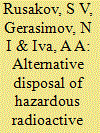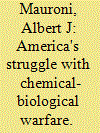|
|
|
Sort Order |
|
|
|
Items / Page
|
|
|
|
|
|
|
| Srl | Item |
| 1 |
ID:
118339


|
|
|
|
|
| Publication |
2012.
|
| Summary/Abstract |
The authors describe a new thermal method for disposing of large hazardous radioactive and clean objects.
|
|
|
|
|
|
|
|
|
|
|
|
|
|
|
|
| 2 |
ID:
001950


|
|
|
|
|
| Publication |
Westport, Praeger Publisher, 2000.
|
| Description |
xvi, 293p.; figures; tables
|
| Standard Number |
0275967565
|
|
|
|
|
|
|
|
|
|
|
|
Copies: C:1/I:0,R:0,Q:0
Circulation
| Accession# | Call# | Current Location | Status | Policy | Location |
| 042976 | 358.30973/MAU 042976 | Main | On Shelf | General | |
|
|
|
|
| 3 |
ID:
107480


|
|
|
|
|
| Publication |
2011.
|
| Summary/Abstract |
An urban wide-area recovery and restoration effort following a large-scale biological release will require extensive resources and tax the capabilities of government authorities. Further, the number of private decontamination contractors available may not be sufficient to respond to the needs. These resource limitations could create the need for decontamination by the building owner/occupant. This article provides owners/occupants with a simple method to decontaminate a building or area following a wide-area release of Bacillus anthracis using liquid sporicidal decontamination materials, such as pH-amended bleach or activated peroxide; simple application devices; and high-efficiency particulate air-filtered vacuums. Owner/occupant decontamination would be recommended only after those charged with overseeing decontamination-the Unified Command/Incident Command-identify buildings and areas appropriate for owner/occupant decontamination based on modeling and environmental sampling and conduct health and safety training for cleanup workers.
|
|
|
|
|
|
|
|
|
|
|
|
|
|
|
|
| 4 |
ID:
126218


|
|
|
|
|
| Publication |
2012.
|
| Summary/Abstract |
Decontaminating civilian facilities or large urban areas following an attack with Bacillus anthracis poses daunting challenges because of the lack of resources and proven technologies. Nevertheless, lessons learned from the 2001 cleanups together with advances derived from recent research have improved our understanding of what is required for effective decontamination. This article reviews current decontamination technologies appropriate for use in outdoor environments, on material surfaces, within large enclosed spaces, in water, and on waste contaminated with aerosolized B. anthracis spores.
|
|
|
|
|
|
|
|
|
|
|
|
|
|
|
|
| 5 |
ID:
093390


|
|
|
| 6 |
ID:
126029


|
|
|
|
|
| Publication |
2012.
|
| Summary/Abstract |
In this article, we analyze feedback from simulated casualties who took part in field exercises involving mass decontamination, to gain an understanding of how responder communication can affect people's experiences of and compliance with decontamination. We analyzed questionnaire data gathered from 402 volunteers using the framework approach, to provide an insight into the public's experiences of decontamination and how these experiences are shaped by the actions of emergency responders. Factors that affected casualties' experiences of the decontamination process included the need for greater practical information and better communication from responders, and the need for privacy. Results support previous findings from small-scale incidents that involved decontamination in showing that participants wanted better communication from responders during the process of decontamination, including more practical information, and that the failure of responders to communicate effectively with members of the public led to anxiety about the decontamination process. The similarity between the findings from the exercises described in this article and previous research into real incidents involving decontamination suggests that field exercises provide a useful way to examine the effect of responder communication strategies on the public's experiences of decontamination. Future exercises should examine in more detail the effect of various communication strategies on the public's experiences of decontamination. This will facilitate the development of evidence-based communication strategies intended to reduce anxiety about decontamination and increase compliance among members of the public during real-life incidents that involve mass decontamination.
|
|
|
|
|
|
|
|
|
|
|
|
|
|
|
|
| 7 |
ID:
107474


|
|
|
|
|
| Publication |
2011.
|
| Summary/Abstract |
Decontamination and recovery of a facility or outdoor area after a wide-area biological incident involving a highly persistent agent (eg, Bacillus anthracis spores) is a complex process that requires extensive information and significant resources, which are likely to be limited, particularly if multiple facilities or areas are affected. This article proposes a systematic methodology for evaluating information to select the decontamination or alternative treatments that optimize use of resources if decontamination is required for the facility or area. The methodology covers a wide range of approaches, including volumetric and surface decontamination, monitored natural attenuation, and seal and abandon strategies. A proposed trade-off analysis can help decision makers understand the relative appropriateness, efficacy, and labor, skill, and cost requirements of the various decontamination methods for the particular facility or area needing treatment-whether alone or as part of a larger decontamination effort. Because the state of decontamination knowledge and technology continues to evolve rapidly, the methodology presented here is designed to accommodate new strategies and materials and changing information.
|
|
|
|
|
|
|
|
|
|
|
|
|
|
|
|
|
|
|
|
|